
The Teloschistaceae are a large family of mostly lichen-forming fungi belonging to the class Lecanoromycetes in the division Ascomycota. Many members of the Teloschistaceae are readily identifiable by their vibrant orange to yellow hue, a result of its frequent anthraquinone content. The presence of these anthraquinone pigments, which confer protection from ultraviolet light, enabled this group to expand from shaded forest habitats to harsher environmental conditions of sunny and arid ecosystems during the Late Cretaceous. Collectively, the family has a cosmopolitan distribution, although members occur predominantly in subtropical and temperate regions. Although most members either live on rock or on bark, about 40 species are lichenicolous–meaning they live on other lichens.

Xanthoria is a genus of lichenized fungi in the family Teloschistaceae. Common names include orange lichen, orange wall lichen, and sunburst lichen. They can be identified by their characteristic squamulose morphology with distinctive "fairy cups".

Flavoplaca is a genus of crust-like or scaly lichens in the family Teloschistaceae. It has 28 species with a mostly Northern Hemisphere distribution.
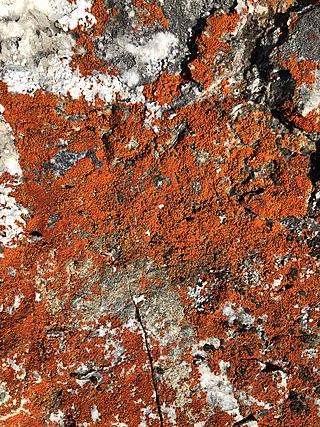
Igneoplaca is a genus in the subfamily Xanthorioideae of the family Teloschistaceae. It contains a single species, the crustose lichen Igneoplaca ignea.
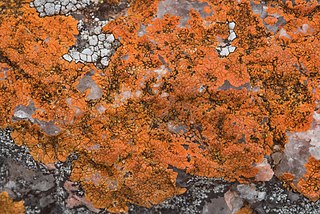
Fulgogasparrea is a genus of crustose lichens in the subfamily Xanthorioideae of the family Teloschistaceae. It has five species. The genus was circumscribed in 2013, with Fulgogasparrea decipioides assigned as the type species; this lichen had originally been formally described as a species of Caloplaca, and then a couple of years later transferred to Wetmoreana. Six are credited with authorship of the genus: Sergey Kondratyuk, Jeong Min-hye, Ingvar Kärnefelt, John Alan Elix, Arne Thell, and Jae-Seoun Hur. The genus name alludes to the resemblance of the type species with both of the Teloschistaceae genera Fulgensia and Gasparrinia.

Squamulea is a genus of lichen-forming fungi in the family Teloschistaceae. It has 15 species. The genus was circumscribed in 2013 by Ulf Arup, Ulrik Søchting, and Patrik Frödén, with Squamulea subsoluta assigned as the type species. Five species were included in the original account of the genus. The genus name alludes to the squamulose growth form of most of its species. Squamulea has a worldwide distribution; when the genus was originally created, the centre of distribution was thought to be in southwestern North America.
Huneckia is a genus of crustose lichens in the subfamily Caloplacoideae of the family Teloschistaceae. It has four species.
Villophora is a genus of lichen-forming fungi in the subfamily Teloschistoideae of the family Teloschistaceae. It has 9 species. The genus was circumscribed in 2013 by Ulrik Søchting, Ulf Arup, and Patrik Frödén. They assigned Villophora isidioclada as the type, and at that time, only species in the genus. This lichen, previously classified in Caloplaca, is found in South America, Antarctica, and some subantarctic islands. Several additional species were added to the genus in 2021. The generic name Villophora means "carrying filaments".
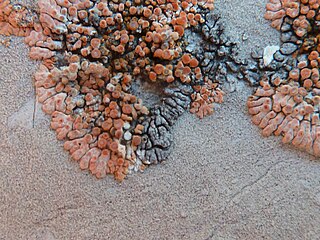
Calogaya arnoldii is a species of saxicolous (rock-dwelling), crustose lichen that is common and widespread in Europe and Asia. It is in the family Teloschistaceae. It was first formally described as a new species in 1876 by Hugh Algernon Weddell, as a species of Lecanora. After being transferred to Caloplaca in 1915, it was considered as a member of that genus for nearly a century. Molecular phylogenetic studies showed Caloplaca to be polyphyletic, and it was divided up into several smaller genera in 2013. Calogaya arnoldii was one of eight species transferred to the newly circumscribed Calogaya by Ulf Arup, Patrik Frödén, and Ulrik Søchting. The lichen is part of a species complex with complicated taxonomy, and in which intermediate phenotypes are frequently observed, making it difficult to reliably distinguish them. Calogaya saxicola is one such similar species, and it has often been confused with C, arnoldii in areas where they co-occur, as the differences between them are subtle.

Wetmoreana is a genus of lichen-forming fungi in the family Teloschistaceae. It has two crustose, saxicolous (rock-dwelling) species.
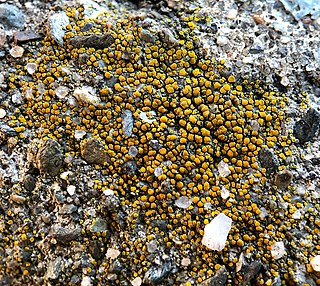
Xanthocarpia feracissima is a species of saxicolous, crustose lichen in the family Teloschistaceae. It was first formally described as a new species in 1953 by Swedish lichenologist Adolf Hugo Magnusson, as a member of the genus Caloplaca. The type specimen was collected in 1939 by John Walter Thomson in Lake Koshkonong, Wisconsin. In the original description, Magnusson notes a similarity to the lichen now known as Gyalolechia flavovirescens, but distinguishes the new species by its lack of a visible thallus, the sordid-reddish color of its discs, and the "unusually narrow" septa of the spores. Patrik Frödén, Ulf Arup, and Ulrik Søchting transferred the taxon to Xanthocarpia in 2013, following molecular phylogenetic analysis of the family Teloschistaceae.
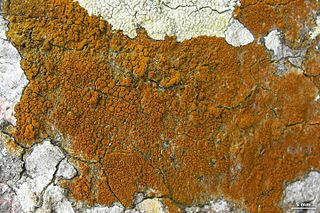
Lacrima is a genus of lichen-forming fungi in the family Teloschistaceae. It has four saxicolous (rock-dwelling), crustose species.

Xanthocarpia crenulatella is a species of saxicolous (rock-dwelling), crustose lichen in the family Teloschistaceae.
Caloplaca nigra is a species of saxicolous (rock-dwelling), crustose lichen in the family Teloschistaceae. Found on rocks predominantly in the Galápagos Islands, it is characterised by its dark reproductive structures.
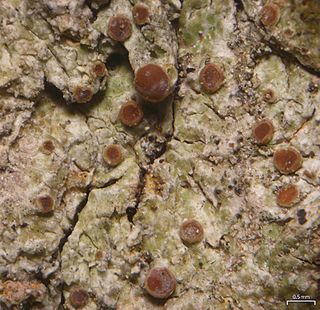
Obscuroplaca is a genus of lichen-forming fungi in the family Teloschistaceae. It contains three species of corticolous (bark-dwelling), crustose lichens.
Solitaria is a fungal genus in the family Teloschistaceae. It contains a single species, the corticolous (bark-dwelling), crustose lichen Solitaria chrysophthalma.
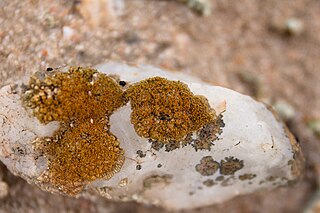
Stellarangia namibensis is a species of saxicolous (rock-dwelling), crustose lichen in the family Teloschistaceae. It was first formally described in 1988 by Ingvar Kärnefelt, as a member of the genus Caloplaca. The type specimen was collected by the author from the gravel flats east of Cape Cross, in Omaruru, Namibia. The same species was collected from Angola by Austrian botanist Friedrich Welwitsch in 1859. The taxon was transferred to the genus Stellarangia in 2013 by Ulrik Søchting and colleagues, as part of a molecular phylogenetics-based restructuring of the Teloschistaceae.
Sirenophila gintarasii is a species of lichen in the family Teloschistaceae. Found in Australia, it was formally described as a new species in 2009 by lichenologists Sergey Kondratyuk and Ingvar Kärnefelt, as a member of the genus Caloplaca. The type specimen was collected by the authors from the Camel Rock reserve. There it was found growing on coastal rock outcrops, along with the crustose species Sirenophila eos and Dufourea ligulata, some of which had been deformed by the lichenicolous fungus species Arthonia sytnikii and Pyrenidium actinellum. The species epithet honours Tasmanian lichen lichenologist Gintaras Kantvilas. Ulf Arup and colleagues transferred the taxon to the genus Sirenophila in 2013, following a molecular phylogenetics-based restructuring of the family Teloschistaceae. Sirenophila gintarasii occurs in New South Wales and Victoria.
Sirenophila eos is a species of saxicolous (rock-dwelling), crustose lichen in the family Teloschistaceae. It was first formally described as a new species in 2007 by Sergey Kondratyuk and Ingvar Kärnefelt, as Caloplaca eos. The type specimen was collected from rhyolite outcrops in New South Wales. Ulf Arup and colleagues transferred the taxon to the newly circumscribed genus Sirenophila in 2013, following a molecular phylogenetics-based restructuring of the Teloschistaceae.













